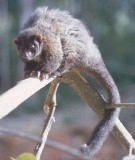Lemuroid ringtail possum

Common name: lemuroid ringtail possum
Scientific name: Hemibelideus lemuroides
Family: Pseudocheiridae
Conservation status:
This species is listed as Least Concern in Queensland (Nature Conservation Act 1992).
Description
Lemuroid ringtail possums are similar in size to a common ringtail possum, and weigh between 750 and 1100 grams. They are a rich chocolate brown colour with paler, greyish-brown underparts and a pale ring around each eye. The muzzle and ears are short and tail long which is bushy for its entire length.
A rare white form of the lemuroid ringtail possum exists in an isolated patch of mature rainforest above 1000 m on the Carbine Tableland, 80 km north-west of Cairns. White individuals are also known to occur among populations of the more common brown lemuroid ringtails. The white lemuroid ringtail is entirely creamy-white in colour with an orange tinge.

Habitat and distribution
Lemuroid ringtail possums live in tall, moist, mature rainforest above 450 metres in altitude, between Cairns and Ingham in north eastern Queensland. Here you may find them in the upper canopy of tall, cool, wet, mature rainforest trees.
Life history and behaviour
During the day, lemuroid ringtails shelter in tree hollows. They emerge at night, leaping noisily about the rainforest canopy while feeding on leaves, flowers and fruit. Lemuroid ringtails are least active when temperatures are below 14 to 16°C.
The lemuroid ringtail is a social species, occurring in pairs or in family groups. Breeding occurs between August and November with the female giving birth to a single young. The dependant young remains with the mother until as late as the following April, after which they become independent.
Threatening processes
Climate change has been suggested as a key threatening process to the lemuroid ringtail possum. The white lemuroid ringtail possum is vulnerable at temperatures above 30°C and cannot survive at temperatures above this for more than 4 or 5 hours. Due to their restricted habitat in cool, moist, high altitude forests, any increase in temperature will impact their ability to maintain their body temperature and will also further reduce their available habitat.
Recovery actions
To understand more about the species, the Centre of Tropical Biodiversity and Climate Change at James Cook University is conducting monitoring and survey work to determine the distribution and abundance of the isolated white lemuroid ringtail population.
Related information
Menkhorst, P and Knight, F 2001. A field guide to mammals of Australia. Oxford University Press, Melbourne, Victoria.
Strahan, R 1983. The Australian Museum complete book of Australian mammals. Angus and Robertson Publishers, Sydney, New South Wales.